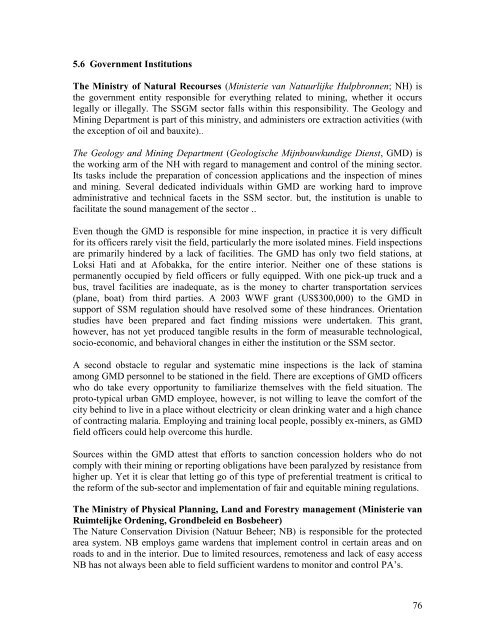SITUATION ANALYSIS OF THE SMALL-SCALE GOLD ... - WWF
SITUATION ANALYSIS OF THE SMALL-SCALE GOLD ... - WWF
SITUATION ANALYSIS OF THE SMALL-SCALE GOLD ... - WWF
Create successful ePaper yourself
Turn your PDF publications into a flip-book with our unique Google optimized e-Paper software.
5.6 Government Institutions<br />
The Ministry of Natural Recourses (Ministerie van Natuurlijke Hulpbronnen; NH) is<br />
the government entity responsible for everything related to mining, whether it occurs<br />
legally or illegally. The SSGM sector falls within this responsibility. The Geology and<br />
Mining Department is part of this ministry, and administers ore extraction activities (with<br />
the exception of oil and bauxite)..<br />
The Geology and Mining Department (Geologische Mijnbouwkundige Dienst, GMD) is<br />
the working arm of the NH with regard to management and control of the mining sector.<br />
Its tasks include the preparation of concession applications and the inspection of mines<br />
and mining. Several dedicated individuals within GMD are working hard to improve<br />
administrative and technical facets in the SSM sector. but, the institution is unable to<br />
facilitate the sound management of the sector ..<br />
Even though the GMD is responsible for mine inspection, in practice it is very difficult<br />
for its officers rarely visit the field, particularly the more isolated mines. Field inspections<br />
are primarily hindered by a lack of facilities. The GMD has only two field stations, at<br />
Loksi Hati and at Afobakka, for the entire interior. Neither one of these stations is<br />
permanently occupied by field officers or fully equipped. With one pick-up truck and a<br />
bus, travel facilities are inadequate, as is the money to charter transportation services<br />
(plane, boat) from third parties. A 2003 <strong>WWF</strong> grant (US$300,000) to the GMD in<br />
support of SSM regulation should have resolved some of these hindrances. Orientation<br />
studies have been prepared and fact finding missions were undertaken. This grant,<br />
however, has not yet produced tangible results in the form of measurable technological,<br />
socio-economic, and behavioral changes in either the institution or the SSM sector.<br />
A second obstacle to regular and systematic mine inspections is the lack of stamina<br />
among GMD personnel to be stationed in the field. There are exceptions of GMD officers<br />
who do take every opportunity to familiarize themselves with the field situation. The<br />
proto-typical urban GMD employee, however, is not willing to leave the comfort of the<br />
city behind to live in a place without electricity or clean drinking water and a high chance<br />
of contracting malaria. Employing and training local people, possibly ex-miners, as GMD<br />
field officers could help overcome this hurdle.<br />
Sources within the GMD attest that efforts to sanction concession holders who do not<br />
comply with their mining or reporting obligations have been paralyzed by resistance from<br />
higher up. Yet it is clear that letting go of this type of preferential treatment is critical to<br />
the reform of the sub-sector and implementation of fair and equitable mining regulations.<br />
The Ministry of Physical Planning, Land and Forestry management (Ministerie van<br />
Ruimtelijke Ordening, Grondbeleid en Bosbeheer)<br />
The Nature Conservation Division (Natuur Beheer; NB) is responsible for the protected<br />
area system. NB employs game wardens that implement control in certain areas and on<br />
roads to and in the interior. Due to limited resources, remoteness and lack of easy access<br />
NB has not always been able to field sufficient wardens to monitor and control PA‟s.<br />
76
















